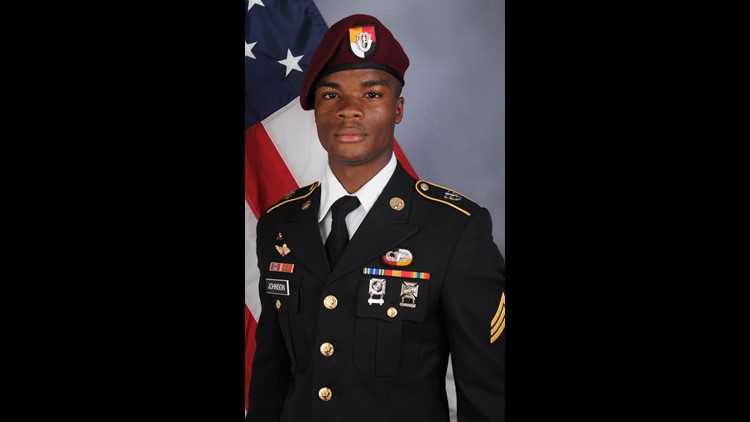With the Pentagon’s final report into the October ambush of a Green Beret-led team in Niger expected by the end of January, CNN is learning new details about the questions investigators have been asking to determine what led to the deaths of four US soldiers.
Two US officials told CNN the military investigation could be followed by administrative action against more than one officer involved in planning and executing the mission. If approved by the Army, reprimands could be issued for failures to follow procedures.
US military officials have previously told CNN that the US-led team was traveling with 30 Nigerien soldiers when they were attacked by approximately 50 ISIS-affiliated fighters armed with rocket-propelled grenades, mortars and heavy machine guns.
During the subsequent gun battle, which lasted for hours, four US soldiers — Staff Sgt. Bryan C. Black, Staff Sgt. Jeremiah W. Johnson, Staff Sgt. Dustin M. Wright and Sgt. La David T. Johnson — were killed and two were wounded.
Five Nigeriens were also killed. US-Nigerien forces managed to kill 20 militants during the firefight, a defense official previously told CNN.
The body of Sgt. La David Johnson was recovered 48 hours after the attack. Additional remains of Johnson’s were recovered on November 12 by a US military and FBI team that traveled to the area.
Investigators expect to answer several key questions about the attack in their final report this month including:
- Was the ambush avoidable?
- Was there an intelligence failure?
- Why did it take 48 hours to find the body of Sgt. La David Johnson?
- Did specific failures result in the 12-man team being being attacked by approximately 50 heavily armed ISIS-affiliated fighters?
Was there an intelligence failure?
Investigators have been probing whether US intelligence agencies gave the troops the most current assessment of the ISIS threat before they were sent into the field.
Multiple officials have said no intelligence operatives were present at the time of the ambush but they did play a role behind the scenes.
Two officials have previously told CNN that initial indications are that a small number of intelligence and law enforcement personnel were working with a second military team that was potentially going to be tasked to capture or kill a high-value target.
That mission was never green-lit, but had it occurred the officials said the team that was ultimately ambushed would have served as emergency backup.
What investigators want to know is why the intelligence did not indicate the presence of ISIS and whether all the proper authorizations and intelligence analysis was conducted.
US officials originally said that they worked off the best intelligence they had at the time.
“This was an ongoing operation, series of operations, based on an assessment that contact with the enemy would be unlikely,” Joint Staff Director Lt. Gen. Kenneth McKenzie said on October 26.
The investigation is assessing who made that judgment and why it was not accurate — a critical question because the team got orders while in the field to visit an ISIS camp that was known to be abandoned to gather intelligence.
“That special forces team did not have a true picture of the environment that they were in,” said Cedric Leighton, a former US intelligence officer. “They didn’t understand the village and local dynamics that they were dealing with. And they also did not understand how close the terrorists were to their operation.”
Officials caution it is still unknown whether the ambush was avoidable as it may have been a case of “wrong place at the wrong time.”
How the ambush unfolded
Critical questions also remain over how the ambush occurred, but top military officials were aware within days of the attack that what was supposed to be a routine patrol was plagued with problems.
Investigators have been assessing the adequacy of communications used by the troops during the battle and how the mission was approved from the beginning.
Military investigators have re-enacted the ambush in an attempt to better understand how the events unfolded.
“Based on what we know so far the attackers used a sophisticated series of tactics. They also understood the kind of tactics that they would need to use in order to defeat the Special Forces Team that was out there,” Leighton told CNN.
The Americans did not request backup from French air support for one hour after making initial contact with enemy forces but it took another hour before the jets arrived as communications proved difficult, officials told CNN.
“I think it’s a fair conclusion to say that about two hours after the initial contact was made the initial French Mirages arrived overhead,” Gen. Joseph Dunford said on October 23.
Three US officials told CNN last month that they are looking to establish if there was a communications breakdown that might have delayed a French response once the ambush began.
Why was Sgt. Johnson’s body not found?
The most emotional issue at hand for investigators is determining the fate of Sgt. La David Johnson.
The ambush sparked global headlines when his body was not found and recovered from villagers for 48 hours after the attack and Trump’s phone call to his widow was poorly received.
Officials said it is unlikely that Johnson was ever alive in enemy hands nor that was he executed as he suffered multiple gunshot wounds.
Ultimately, officials told CNN that the 12-man Green Beret-led team on the ground fought against the attackers with valor and that medals are expected.



